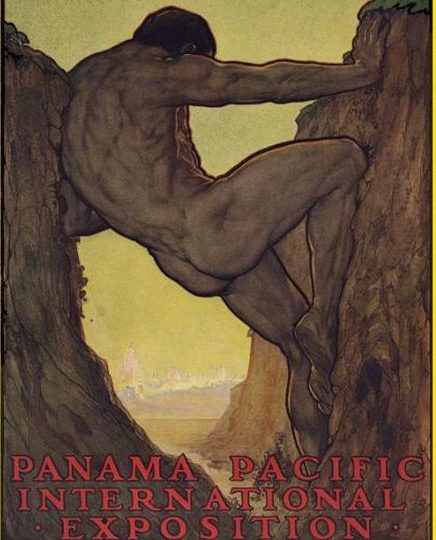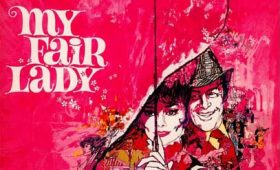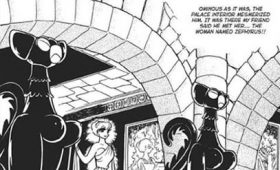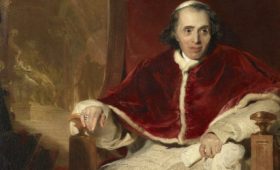Perham Wilhelm Nahl, “The Thirteenth Labor of Hercules” (1915), color offset lithograph (as booklet cover and broadside poster), advertisement for the Panama-Pacific International Exposition held at San Francisco 20 Feb – 1 Dec 1915. The original is now held in a private collection.
— OGCMA HeraclesLaborsSuite2.0001
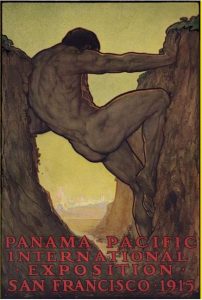
Classical Sources:
See ogcma.byu.edu/HeraclesLaborsSuite1.0000_Reid.htm
Heracles in classical mythology performed twelve canonical labors and many parerga (secondary accomplishments). Many parerga were of substantial importance, but still not typically canonized as The Twelve were. One such parergon was Heracles’ treatment of the Straits of Gibralter, known anciently as The Pillars of Heracles.
This act was performed by the hero in conjunction with the tenth labor, the theft of Geryon’s cattle. On his way to Erytheia, Heracles set up two massive stone pillars at Calpe (Gibraltar, on Europe) and at Abyla (Ceuta, on Africa) and marked thereby the boundary between Mediterranean and Atlantic. The civilizing impulse could be seen to demarcate the Ocean’s wild, unknown monstrosity from the domesticated safety inside the Mediterranean. Pindar (Oly. 3.43-45, Nem. 3.19-23, Isth. 4.11-13) considered the Pillars as a boundary beyond which human striving becomes especially perilous. Some tellings specifically clarify that Heracles more than only marked, but even created the strait by separating the geological landmasses.
Nahl’s adaptation of this moment in the Heracles myth injects (super-)Herculean magnitude into the 1915 Panama-Pacific Exposition. That fair celebrated the creation of the Panama Canal and defined San Francisco as officially reborn after 1906’s devastating earthquake. One of the “Seven Wonders of the Modern World”, the Canal opened in 1914 a safe and hugely abbreviated passage between Atlantic and Pacific through Central America. American enterprise accomplished the feat of international engineering begun nearly forty years earlier by the French. Nahl depicts the titanic accomplishment in his broadside illustration — a cruiser steaming through the canal toward the recognizable PPIE skyline of San Francisco is dwarfed by the enormous hulk of Heracles, who sunders the landmasses of North and South America. So miniscule is the ship that it looks like a hyphen Nahl’s painting. The profile of the Herculean backside bears a conscious resemblance to the Pacific coastline from San Francisco (shoulderblade) to Chile (left heel). An engineer sees the canal as a feat of human persistence, while an artist sees an even greater force at work. Opening the Panama Canal is Heracles’ “Thirteenth Labor” [of twelve]. By such a measure, Nahl boldly asserts that the hero’s culminating accomplishments, fetching the Apples of the Hesperides and escorting Cerberus to the world of the living, were not the end of his sanctifying career.
Perlham Wilhelm Nahl (1869-1935) was a San Franciscan artist who worked with classical mythological adaptations — such as the Graces, Apollo and Daphne, perhaps Baucis and Philemon, and others — without always being beholden to the classical myth. No work by Nahl is listed in the printed OGCMA. Nor is Nahl treated in Oxford Art Online.
A medallion was struck in 1979 to commemorate the ¾-centennial of the Panama Canal’s inception.

A 1979 medallion coin after Nahl’s “Thirteenth Labor”, inscribed by Hyde. — HeraclesLaborsSuite2.0002_NahlHyde
Bibliography
Nolte, Carl. “Panama-Pacific fair changed San Francisco forever,” San Francisco Chronicle 14 Feb 2015; https://www.sfchronicle.com/news/article/Panama-Pacific-fair-changed-San-Francisco-forever-6080573.php (accessed 31 July 2020).
University of California (System) Academic Senate. 1935. University of California: In Memoriam, 1935. Archived on Calisphere (calisphere.org; accessed 31 July 2020).
